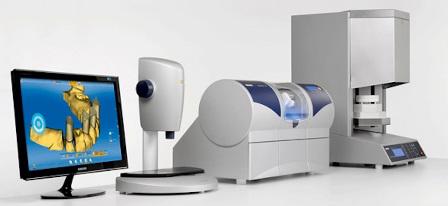Each of the stages of CAD/CAM production of dental structures (whether it is the collection of digital data, their processing by adapted software or the process of manufacturing a prosthesis or crown itself) continues to develop and improve independently, thus ensuring even greater accuracy and efficiency of orthopedic works made by digital modeling and milling. At the same time, new materials of ceramics, polymers and metals are being introduced into CAD/CAM practice, which allow us to manufacture all types of structures: from simple caps and crowns to all-arc prostheses, removable devices, medical units, positioners and surgical templates. CAD/CAM laboratories also use materials for the manufacture of models, or samples that are subject to burnout during casting or pressing.
Table of Contents
CAD / CAM materials in dentistry
CAD / CAM ceramics are most often used in restorative dentistry, since the introduction of such an approach has significantly changed the key clinical aspects in this practical industry. Most of the bridge-like structures, as well as single crowns, are currently manufactured using CAD/CAM technologies using new types of ceramic materials. CAD / CAM ceramics have evolved from a classic feldspar analog with high aesthetic characteristics, but fragile in nature, to modern brand representatives, which differ very significantly in the parameters of strength, flexibility and aesthetics. Structures made of such materials have long proven their clinical effectiveness and are a worthy replacement for traditional metal-ceramic restorations.
Until recently, clinicians were limited in the choice of CAD/CAM ceramic materials: durable materials did not have sufficient aesthetics, and aesthetic materials did not have sufficient strength. But today, the aesthetic parameters of high-strength materials allow us to achieve the maximum clinically effective result, regardless of the amount of work: whether it is a single crown or an all-arc design that replaces the full adentia of the jaw. Monolithic CAD/CAM restorations are less prone to failure due to the lack of difference between the base and coating materials, and the process of their manufacture is quite fast and easy, which does not require labor-intensive additional costs and highly qualified knowledge about the features of applying different coating layers.
Vitreous ceramics
Vitreous ceramics is a unique CAD / CAM material that has been used for the manufacture of inlays, crowns and veneers for over 30 years. With adequate use of this type of materials (a proper preparation algorithm, an adapted method of processing ceramics and a reliable bonding protocol), they provide a fairly high level of clinical success and aesthetic rehabilitation. However, in cases with excessively thin borders, mismatch of surfaces and insufficient adhesive bond with the tooth structure, the effectiveness of the use of vitreous ceramic structures leaves much to be desired. For some cases, other types of materials are more suitable, but for veneers, glass-ceramic remains the best material of choice. Vitreous ceramics are available in the form of multi-layered blocks, differing in shades of color. In addition, it can be additionally tinted or changed by applying an additional layer, which in most cases solves the problems of individual color selection of the future aesthetic design.
Nanoceramics
This group of materials combines the elasticity of composites and the strength of ceramic analogues. Nanoceramics cannot be painted in a furnace, which limits their use for restorations in the frontal area, but to give them an appropriate shade, there are whole restoration kits that help to achieve maximum color adaptation. Most recently, 3M ESPE stopped offering to use its own Lava Ultimate for the manufacture of crowns due to frequent cases of violation of the bonding of orthopedic structures with tooth tissues. Inlays and overlays are direct indications for the use of nanoceramics during milling due to the lack of thin edges that are sensitive to chips, less flexibility and better adhesion of such structures. From a clinical point of view, nanoceramic pads and inlays are made quite quickly, while they are precisely and easily polished during their final fitting and fixing.
LAVA Ultimate (3M ESPE)
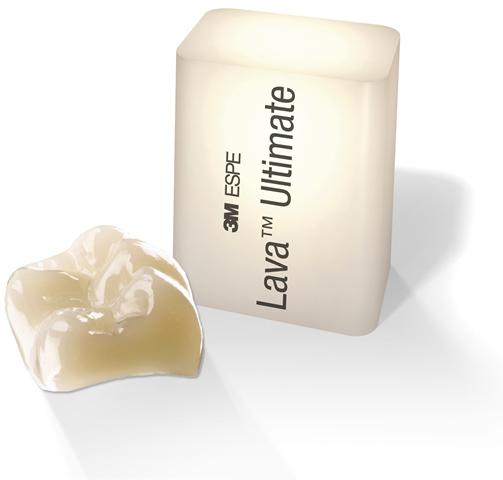
Lithium silicate Glass Ceramics
Lithium disilicate was introduced into the dental industry by Ivoclar Vivadent under the name Empress II back in 1998. At first, the material was too opaque, so the coating ceramics were sintered directly on the disilicate substructure. But he definitely did not stop and, continuing to improve the aesthetic parameters of disilicate materials, he achieved success: today lithium disilicate is presented on the market with different degrees of transparency, thanks to which it can be used both for veneers, and for single crowns or bridge-like structures that overlap the premolar region. Also, this material is effectively used for the manufacture of abutments and crowns based on implants. To date, the strength, aesthetics and strength of fixing lithium silicate structures using conventional composite cements have been scientifically and clinically proven, so the versatility of this group of materials is beyond doubt.
A number of companies have presented analogues of these materials on the market that have comparable strength parameters. Such products include Obsidian (Prismatik Dentalcraft Inc.) – lithium silicate and CELTRA Duo (DENTSPLY International) – zirconium reinforced with lithium silicate. Their final color is determined immediately before the sintering process, but sufficient data on their effectiveness for the manufacture of IPS e. max (Ivoclar Vivadent) has not yet been obtained. In addition, these commercial representatives of lithium disilicate cannot be applied in layers, and the spectrum of their transparency shades is significantly limited. This type of materials is often the best choice for single restorations or for triple bridges in the frontal area.
IPS e.max CAD (Ivoclar Vivadent)
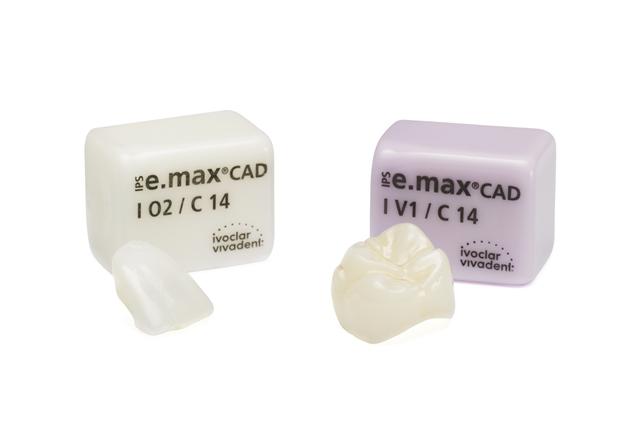
TRINIA CAD / CAM Unit (Shofu)
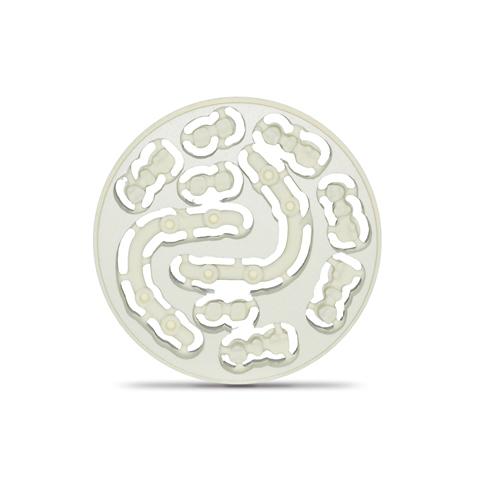
Zirconium
Initially, zirconium was considered only as a material for the manufacture of a substructure due to its high opacity. The bending strength parameter of zirconium is similar to that of metals, however, when it is coated with more transparent ceramics, there is a risk of chipping during operation. Over the past ten years, manufacturers have nevertheless achieved that new zirconium materials with adapted transparency levels can be used for the manufacture of aesthetic crowns and bridges in the frontal area. Zirconium blocks for milling currently have a multi-set of shades, thus providing opportunities for the full-fledged production of crowns that are more opaque at the gum and more transparent at the cutting edge. As a rule, the more aesthetic the zirconium material is, the less durable it is, but even such strength levels are sufficient for bridge-like structures to function successfully in the frontal area. Also, the advantage of zirconium is its high strength of adhesion even when using conventional cements, but at the same time, these materials are quite difficult to mill and modify if necessary adjustments. A practicing dentist should know which type of zirconium is better to choose for the restoration of the posterior group of teeth, since the variability of the strength of materials, as well as their aesthetic parameters, is quite wide.
Zirkonzahn’s Prettau Zirconia
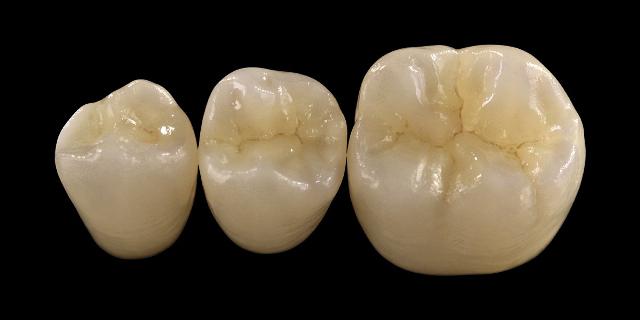
Milling process
All three categories of CAD / CAM materials (polymers, metals and ceramics) can be processed by subtractive production technology, in which part of the material is removed from a monolithic block or disk until the planned shape of the future structure is achieved. The final appearance of the crown or bridge is achieved through the final processes of milling or grinding of excess material, and in the case of metals – by means of electroerosion treatment. A significant advantage of subtractive production is that monolithic blocks and disks are manufactured under industrial control, so there is no doubt about their quality. In addition, this point in relation to ceramics helps to avoid the occurrence of defects resulting from internal stresses and shrinkage caused by the nature of the layered application process. In the case of metals, the production of structures from a monolithic block eliminates the aspects of deformation of the material as a result of casting during periodic heating with subsequent cooling. Thus, thanks to CAD/CAM technologies, any material can provide more durable and aesthetic structures compared to traditional laboratory methods of manufacturing inlays, crowns or bridges. On the other hand, there is a whole range of materials developed specifically for CAD / CAM production, which cannot be used in a conventional laboratory.
The subtractive processing method, however, can be somewhat uneconomical, since most of the monolithic block is crushed and becomes unsuitable for further use. Milling drills, which wear out over time, also do not provide sufficient accuracy during prolonged use. In the case of ceramics, the milling process can provoke the occurrence of stresses and cracks in the structure of the material. But, even despite such disadvantages of CAD/CAM technologies, the milling method of manufacturing structures is much more accurate and economical than the usual laboratory method of manufacturing restorations.
The additive method of manufacturing structures is used mainly when working with plastics or metals. This process involves applying thin layers (about 30 microns thick) of material to recreate an adequate three-dimensional object. Such a production method can be implemented through various technologies: three-dimensional printing, stereolithography and laser welding. The method of forming a liquid interfacial boundary (continuous liquid interface production – CLIP) is a kind of know-how even in the environment of CAD/CAM technologies, providing unique accuracy and efficiency. The final product with this technology is produced from a “pool of liquid” by recreating a certain interphase boundary. In the cases of 3D printing, at first this method was suitable only for the production of prototypes, but at this time it has significantly expanded its capabilities. With the possibility of printing plastics of different colors, it is becoming more and more effective for the manufacture of monolithic plastic prostheses. Regarding crowns and bridges, the above-mentioned methods are without exaggeration revolutionary, since they allow using materials with maximally improved mechanical properties, individualizing and adapting the design, and also eliminate the disadvantage of the subtractive method – the presence of a huge amount of expensive, but not suitable for further production of waste.
Conclusion
CAD / CAM materials continue to develop and improve rapidly, providing dentists with new, more effective opportunities for treating patients. Therefore, doctors should be aware of the range of materials available to ensure an individualized approach to each clinical situation. Undoubtedly, the existing materials will continue to develop, initiating the emergence of new CAD/CAM production methods, and therefore monitoring the dynamics of progress and improvement will provide a more adaptive approach to the choice of the treatment algorithm for each individual patient.

